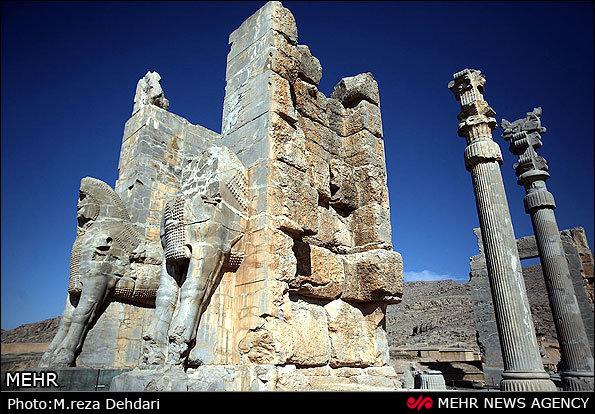
Since many years ago, growth of lichens had been seen as a threat to the global heritage of Persepolis, and a disturbing issue for the academia; researchers believe that in the long run, lichens could blur the carved stones in Persepolis and other monuments, which made them to seek the remedy. Masoud Rezaei Monfared is such a researcher who addressed the issue and ultimately hit a method; Rezaei Monfared is the head of Persepolis Complex; “the research work on the lichens growing on stones of Persepolis has long been underway and its results will be published in National Week of Research,” he told Mehr News provincial correspondent.
The research was conducted by Iranian Research Organization for Science and Technology (IROST) since 4 months ago on lichens growing on Persepolis stone slabs; Mohammad Sohrabi one of the research fellows says innovative methods to eliminate lichens from the stone surface, which had proved extraordinarily effective. “Currently we are working on registration of the novel method; we call it ‘soft battle’ with lichens, since the outcome is not harmful to carved shapes and inscriptions including erosion, change of color, or other types of damage,” he added. “This is good news for the lovers of Persepolis; the method will be communicated to the public having been registered as an effective method in removing lichens; more than 100 species of lichens have been identified in Persepolis; by 2003, this figure was only 65; however, not all lichen species are harmful to the stony surfaces. They are different in their chemicals release and their effect on the bedrock where they grow,” he detailed.
Sohrabi is PhD of Lichenology; “a host of theories had been presented on the growth of lichens on Persepolis by different scientists; our research identified a new species of lichens, which is native to Persepolis. Nowhere in the world had this lichen been identified,” he told Mehr News. “Two overriding theories explain the growth of lichens on lithic surfaces; the first theory contends that lichens actually supports the carved shapes and inscriptions of stone surfaces against weathering; others however, believe that they are factors of gradual fading away of carvings. A collection of ecological, physiological, and reproductive factors contribute to lichens growth on stone surfaces. Lichens growth in all stone monuments,” he asserted.
“Lichens are the same age as the genesis of the planet, and will remain so for the future to come; however, human civilization had produced masterpieces which should be protected for generations to come; the efforts to protect cultural heritage have contributed to the dominant view that lichens are destructive to historical monuments and surfaces,” Sohrabi told Mehr News. “The lichen onslaught is not limited to Iranian monuments; during recent few years, great work had been carried out in a scientific surveying of lichen species growing in Persepolis,” he added.

Add new comment